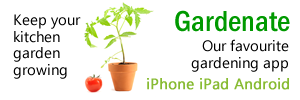Growing Cucumber
cucumis sativis : Cucurbitaceae / the gourd family
| Jan | Feb | Mar | Apr | May | Jun | Jul | Aug | Sep | Oct | Nov | Dec |
|---|---|---|---|---|---|---|---|---|---|---|---|
| S | S | ||||||||||
| T | T | T | |||||||||
| P | P |
(Best months for growing Cucumber in USA - Zone 5a regions)
- S = Plant undercover in seed trays
- T = Plant out (transplant) seedlings
- P = Sow seed
- Sow in garden. Sow seed at a depth approximately three times the diameter of the seed. Best planted at soil temperatures between 61°F and 95°F.
- Space plants: 16 - 24 inches apart
- Harvest in 8-10 weeks. Cut fruit off with scissors or sharp knife.
- Compatible with (can grow beside): Nasturtiums, Beans, Celery, Lettuce, Sweet Corn, Cabbages, Sunflowers, Coriander, Fennel, Dill, Sunflowers
- Avoid growing close to: Potato, Tomatoes

Your comments and tips